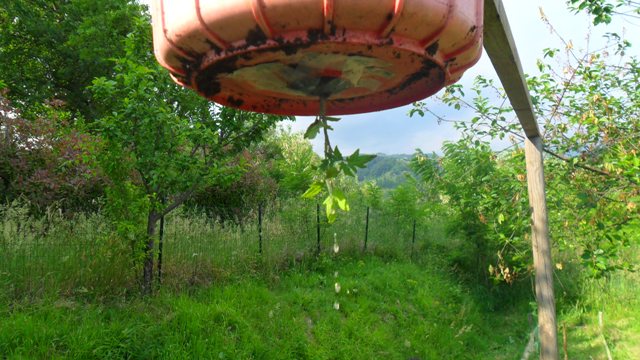
Whilst I was about to plant my tomatoes a couple of southern hemisphere thoughts popped into my mind. I started to think laterally about their vertical position and came to the conclusion that tomatoes grow perpendicular to the earth’s surface, hence southern hemisphere tomatoes grow upside down compared to northern hemisphere tomatoes. So based on the fact that tomatoes have no directional preference here is the latest addition to my raised bed veggie garden.
In theory gravity makes the water run down, so an upside down tomatoes does not need to spend any of it’s energy pulling it up… hence all it’s energy goes towards making nice juicy tomatoes.
– Take an old bucket
– Make hole in bottom
– Fill with soil and put on lid
– Turn bucket upside down and plant tomatoe (yes the lid was to stop the soil falling out)
– Place a little sticky tape around the hole (stops mud coming out)
– Hang and wait for it to grow (ps: you don’t need any canes to either)
As you can see the watering is a little more difficult but you do gain lots more space….
Oh, an added benefit, when people start boasting about their tomatoes, I proudly say that mine are over two meters high.
no images were found
 Stavo per piantare i pomodori quando un paio di pensieri mi sono saltati alla mente: ho cominciato a pensare lateralmente al loro portamento verticale e sono arrivato alla conclusione che i pomodori crescono perpendicolari alla superficie terrestre, per cui le piante che crescono nell’emisfero sud vengono fuori a rovescio confronto a quelle dell’emisfero nord.
Stavo per piantare i pomodori quando un paio di pensieri mi sono saltati alla mente: ho cominciato a pensare lateralmente al loro portamento verticale e sono arrivato alla conclusione che i pomodori crescono perpendicolari alla superficie terrestre, per cui le piante che crescono nell’emisfero sud vengono fuori a rovescio confronto a quelle dell’emisfero nord.
Quindi, partendo dal fatto che i pomodori non hanno preferenze sulla direzione da prendere, ecco l’ultima novità a proposito del mio orto.
Stando alla teoria, la gravità fa scendere l’acqua verso il basso, per cui un pomodoro seminato a testa in giù non dovrebbe aver bisogno di spendere energie per poi ritirarla su… e tutta questa energia potrebbe essere sfruttata dalla pianta per far crescere dei bei pomodori succosi:
– Prendete un vecchio secchio
– Fate un foro sul fondo
– Riempite di terra e mettete il coperchio
– Rovesciate il secchio sotto sopra e seminate una pianta di pomodoro nel foro (il coperchio servirà a non far cadere fuori la terra)
– Sistemate dello scotch attorno al foro (non farà uscire il terriccio)
– Appendete ed aspettate che qualcosa cresca (non avrete nemmeno bisogno delle calocchie)
– Vi accorgerete che annaffiare sarà un po’ più complicato, ma ne vale la pena con lo spazio che se ne guadagna
– In più, quando gli altri cominceranno a lamentarsi dei loro pomodori, io potrò dire che i miei sono già alti più di due metri.





One important note to add. It is essential that an antipodal tomato be peeled counter-clockwise, and from the inside out. Otherwise the seeds will spill across the International Dateline with undesirably consequences.
True Frank, and another important note is that with today’s global markets and faster airplanes the international dateline is becoming a real problem in terms of expiry date labelling.
And exactly how many miles is this garden from Reading?
http://en.wikipedia.org/wiki/As_It_Happens
As It Happens host will conclude the piece by straight-facedly noting how far the UK location is from Reading, frequently giving the distance in both miles and some other form of strange, non-standard measurement (e.g., 733,000 garden gnomes, lined up hat to hat)…..
his name has been added to the black list
These intrepid gnomes have found a green wooded valley, far away from all the problems and pollution of modern life and have started to rebuild their lives with their new found freedom. Some have even re-found their trust in the human race and have started to inhabit the towns again.
“These intrepid gnomes have found a green wooded valley, far away from all the problems and pollution of modern life and have started to rebuild their lives with their new found freedom.”
Are you referring to the state of Maine?
Well I think they were referring to Beauly, Nova Scotia, which by the way is about 2849 miles west of Reading.